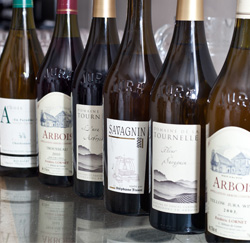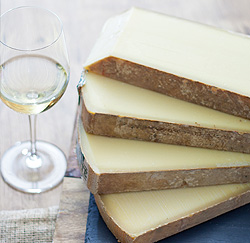When invited to a Comté tasting at the Wine & Spirits office on a winter Wednesday morning, I expected some terrific cheese. I expected to examine spring versus summer milk, to hear about the cows grazing and how it was a terroir-driven cheese. I didn’t expect to geek out on the effect that microflora has on cow teats and how that might affect the relationship of terroir and cheese.
Comté is one of the four respected cheeses that come from the Franche-Comté region, also home to the Jura, an appellation never far from my wine-drinking wishes. The cheese can be nutty, fruity, with brilliant acidity and a fabulous affinity for the local oxidized white wines. It is also the best melter in potato dishes and one of the contraband cheeses I suitcase back to the States after a visit to Marie-Anne Cantin’s wonderful Parisian fromagerie in the 7th. Comté is released after four months but as Cantin taught me, it sings best between 18 and 24. While there are other cheeses made in the same way—Gruyère and Emmenthal—to me there’s no doubt that Comté has that extra je ne sais quoi.
The tasting table at W&S held four very beautiful slabs of the cheese, in varying shades of hay, chunked out on a rustic board. They were 15 or 16 months of age, each from a different fruitière, as the locals call their cheese-making facilities. They were all made from the milk of the Montbéliarde cow. In accordance with Appellation d’Origine Protégée (AOP) laws, they chomped on grass no more than 15 miles from the fruitière before being shipped off for their affinage, the cheese equivalent of élevage.
We set to our mousing. The cheeses were all distinct, so much so it was actually difficult to believe they were the same age. The first was earthy and creamy but a little flat. Number Two was the most fragrant,with a peanut finish and high acidity. The third seemed the classiest to me, with a drier curd and plenty of depth, and the darkest in color. It was singular, from the Belleherbe factory, which, like Number Two’s fruitière, is in Le Doubs, the department next to the Jura. The last cheese was very pale, with some crunch to its savory flavors.


The rennet question comes from a vivid memory I have of a visit to a cheese-making facility not far from Arbois. I had to suit up so thoroughly I could have been entering an infectious disease lab. White coat. Shower cap. Plastic booties. Inside, milk was roiling away in huge copper vats. Rounds of aging cheese were stacked like gold blocks in a treasury. Emerging from the cold room, chatting with the workers, I became aware of a putrid smell. A worker had entered the hallway with a paper bag. The closer she got, the stronger the smell; like an unwashed belly button, one that had escaped a cloth for a decade. It was the fourth stomach of a young calf—the source of the rennet that would coagulate the next day’s batch. It was hard to comprehend that here, under the EU’s strict rules regarding hygiene and in an era that favors the use of genetically modified rennet, there were still fromagers working in this traditional way. Was this a parallel to wine producers who avoid laboratory yeast cultures, preferring to allow fermentation to start on its own with indigenous yeasts?
Breaking in on my reverie, the microflora teat bomb. Forget what the cows eat. Forget the limestone versus glacial deposits called moraine. Forget the rennet. “It’s about the microflora,” said Jean-Louis Carbonnier, a representative of the Comté board who’d organized the tasting. He was describing research the board had conducted on the factors that influence terroir expression in cheese.


Once home, I came up with a 2012 study in the Applied and Environmental Microbiology Journal that studied this effect on Cantal, another AOP cheese. There it was: “A host of bacteria that live on cow teat skin may contribute to the development of the sensory characteristics of cheese during ripening.”
That night, I pulled out a wine from Pupillin, from Philippe Bornard, a savagnin that had spent four years sous voile, aging under a flor-like yeast. Sipping it to wash down some leftover Belleherbe, I thought about the American obsession with antiseptic food production, the belief that it leads to goodness and health. And it also struck me that the tenders of the appellation system in France—which rejects so many fine wines, cursing them from the appellation to the generic vin de France—could learn from those who protect their cheese. Authentic wine and cheese both need their funky bits.
This story was featured in W&S April 2013.
photos by Mary Brown
This story appears in the print issue of April 2013.
Like what you read? Subscribe today.















